

Label the heart. Boundless Anatomy and Physiology. Heart Circulation Coronary circulation is the circulation of blood in the blood vessels of the heart.
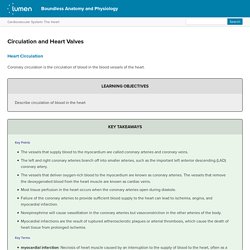
Learning Objectives Describe circulation of blood in the heart Key Takeaways Key Points The vessels that supply blood to the myocardium are called coronary arteries and coronary veins.The left and right coronary arteries branch off into smaller arteries, such as the important left anterior descending (LAD) coronary artery.The vessels that deliver oxygen-rich blood to the myocardium are known as coronary arteries. Key Terms myocardial infarction: Necrosis of heart muscle caused by an interruption to the supply of blood to the heart, often as a result of prolonged ischemia.ischemia: Oxygen deprivation in tissues due to mechanical obstruction of the blood supply, such as by a narrowed or blocked artery or clot.angina: Chest pain that indicates ischemia in the heart.
Examples Atherosclerotic plaques in a coronary artery will slowly occlude (block) the vessel. Heart disease - Health & Wellbeing. By Peter Lavelle and Jane McCredie What is heart disease, how is it treated and how can you prevent it?
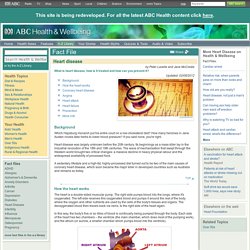
Updated: 02/08/2012 [Image source: iStockphoto] Background. Cardiovascular System: Coronary arteries. (5) Cardiovascular Disease Overview. Risk Factors - Heart Research Australia. Cardiovascular disease: Australian facts 2011, Summary. Heart problems and cardiovascular health. Flu infection may make cardiovascular disease (e.g. heart attack, stroke) and associated death more likely, and flu vaccination may reduce this risk.

We included randomised studies comparing people receiving flu vaccine with those receiving no vaccine (placebo or no treatment). For this review update, we found eight trials studying 12,029 participants. Four of these studies examined patients with known heart disease (1682 participants), and the other four focused on the general population or elderly people (10,347 participants). The general population studies reported cardiovascular disease outcomes as part of their safety analyses, but the numbers of cases were too few to allow a judgement on whether flu vaccination was protective in these populations, and no differences were seen between groups. Heart Attack Due to Atherosclerosis. Diabetes - Heart Research Institute. High Blood Pressure - Heart Research Institute. Heart disease. These foods will lower your risk of heart disease.
Low-fat or low-carb?
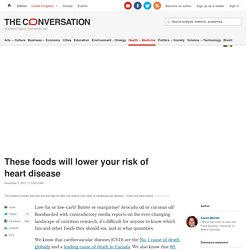
Butter or margarine? Avocado oil or coconut oil? Bombarded with contradictory media reports on the ever-changing landscape of nutrition research, it’s difficult for anyone to know which fats and other foods they should eat, and in what quantities. We know that cardiovascular diseases (CVD) are the No. 1 cause of death globally and a leading cause of death in Canada. We also know that 80 per cent of chronic disease could be alleviated by following a healthy diet, avoiding tobacco, maintaining a healthy weight and getting regular exercise. In an effort to follow a healthy diet, it’s easy to focus on individual nutrients. We eat food — ideally three to six times per day — not individual nutrients. Ah16 3 5 coronary heart disease. Brain Foundation. Stroke is a medical emergency.
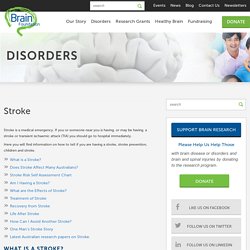
If you or someone near you is having, or may be having, a stroke or transient ischaemic attack (TIA) you should go to hospital immediately. Here you will find information on how to tell if you are having a stroke, stroke prevention, children and stroke. What is a Stroke? Stroke - Diagnosis and treatment. Quizlet Flashcards for Stroke/Hypertension. World Health Organization - Insufficient physical activity. Risk factors to health, Overweight and obesity. Healthy Weight Guide. Mayo Clinic Minute: The Problem With BMI. What BMI doesn't tell you about your health. 10 Leading Causes of Weight Gain and Obesity. World Rankings: Obesity Rates by Country (July 2017) Why are these countries obese? Walking is just one reason. WHICH COUNTRY HAS BIGGEST OBESITY PROBLEM? BBC NEWS. Hormone control of hunger. Children to be weighed and measured at school every two years in proposal to tackle obesity. Updated Children's height and weight would be measured every two years unless parents opt out as part of an ambitious proposal to tackle Australia's obesity epidemic.

The proposal, made by the Global Obesity Centre (GLOBE) at Deakin University to a Senate committee examining the issue, argues the data could map childhood obesity around Australia to better target where the problem is at its worse. The prevalence of overweight and obese young Australians aged 5 to 17 was 27 per cent in 2014/15, according to the Australian Health Survey. But GLOBE's Steven Allender said the rate of obesity was likely higher. "The information we have is really quite inaccurate," Professor Allender said. Diabetes Type 1 and Type 2, Animation. Diabetes Complications. Search the A-Z of complications: Complications of diabetes are attributed to prolonged levels of high blood glucose Uncontrolled diabetes can lead to a number of short and long-term health complications, including hypoglycemia, heart disease, nerve damage and amputation, and vision problems.
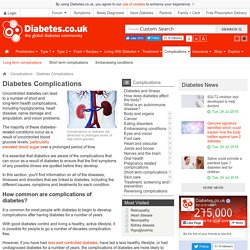
The majority of these diabetes-related conditions occur as a result of uncontrolled blood glucose levels, particularly elevated blood sugar over a prolonged period of time. It is essential that diabetics are aware of the complications that can occur as a result of diabetes to ensure that the first symptoms of any possible illness are spotted before they develop. In this section, you'll find information on all of the diseases, illnesses and disorders that are linked to diabetes, including the different causes, symptoms and treatments for each condition. What is Osteoporosis and How to prevent it. Quizlet Flashcards for Osteoporosis. Type 1 osteoporosisPorous trabecular bone characterised by rapid bone demineralization following menopauseType 2 osteoporosisgradual loss of Bone Mass Density (BMS) that occurs in both men and women with advancing ageTrabecular BoneInterior, spongy bone with a porous, honeycomb structureCortical Bonehard, dense, strong bone that forms the outer layer of bone; also called compact boneBiophosphonatesinhibit normal & abnormal bone resorption which increases bone mineral densityDenosumab6 monthly injection that slows the rate at which bone is breaking downSelective oestrogen receptor modulators (SERMS)Daily tablet that slows bone loss, reducing the risk of spinal fractures in women who have been through menopauseHormone replacement therapy (HRT)Replacement of hormones, oestrogen and/or progesterone, to slow bone deterioration.
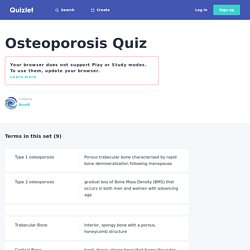
Impact of physical inactivity as a risk factor for chronic conditions. Physical activity. What is physical activity?
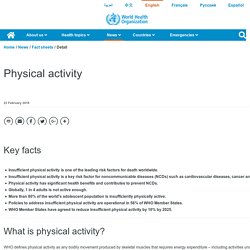
WHO defines physical activity as any bodily movement produced by skeletal muscles that requires energy expenditure – including activities undertaken while working, playing, carrying out household chores, travelling, and engaging in recreational pursuits. The term "physical activity" should not be confused with "exercise", which is a subcategory of physical activity that is planned, structured, repetitive, and aims to improve or maintain one or more components of physical fitness.
Beyond exercise, any other physical activity that is done during leisure time, for transport to get to and from places, or as part of a person’s work, has a health benefit. Further, both moderate- and vigorous-intensity physical activity improve health. Physical activity review 2013. Impact of physical inactivity as a risk factor for chronic conditions: Australian Burden of Disease , Summary. Impact of changes in television viewing time and physical activity on longevity: a prospective cohort study.
The impact of changes in leisure time physical activity on changes in cardiovascular risk factors: results from The Finnmark 3 Study and SAMINOR 1, 1987–2003. Research and Statistics: key facts and figures regarding physical activity and sedentary behaviour. Regular physical activity is an important contributor to good overall health, including promoting healthy weight and reducing chronic disease risk.
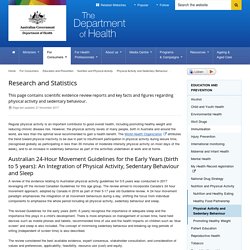
However, the physical activity levels of many people, both in Australia and around the world, are less than the optimal level recommended to gain a health benefit. The World Health Organization attributes the trend toward physical inactivity to be due in part to insufficient participation in physical activity during leisure time, (recognised globally as participating in less than 30 minutes of moderate intensity physical activity on most days of the week), and to an increase in sedentary behaviour as part of the activities undertaken at work and at home. Australian 24-Hour Movement Guidelines for the Early Years (birth to 5 years): An Integration of Physical Activity, Sedentary Behaviour and Sleep Further details about the process used to conduct this review can be found at: BMC Public Health.
Positive Impact on Physical Activity and Health Behaviour Changes of a 15-Week Family Focused Intervention Program: “Juniors for Seniors” Behavior Change with Fitness Technology in Sedentary Adults: A Review of the Evidence for Increasing Physical Activity. 2016 Physical Activity and Sedentary Behaviour 1. The Future of Australian Sport.